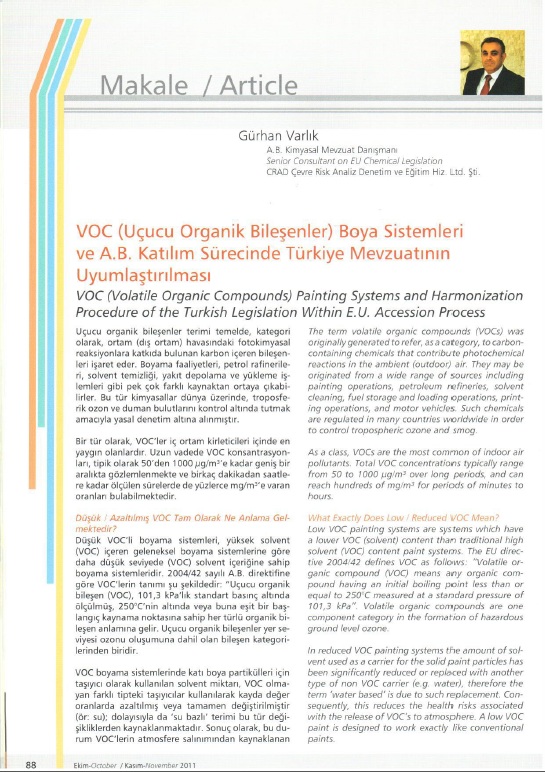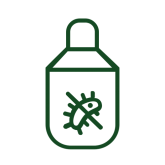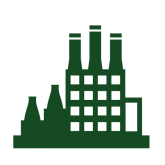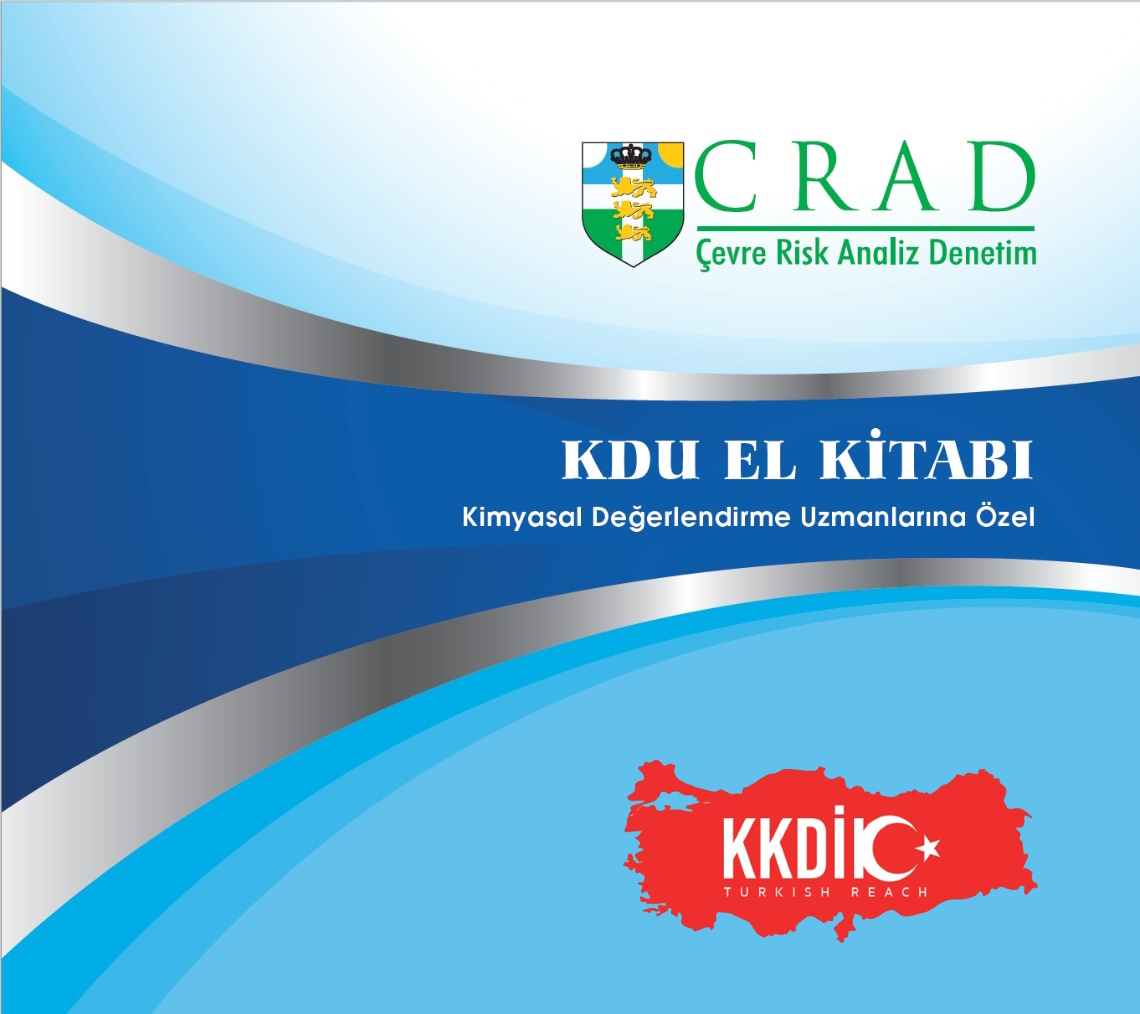VOC (VOLATILE ORGANIC COMPOUNDS) PAINTING SYSTEMS AND HARMONIZATION PROCEDURE OF THE TURKISH LEGISLATION WITHIN E.U. ACCESSION PROCESS
Boyatürk Magazine - 2012 October-November
 The term volatile organic compounds (VOCs) was originally generated to refer, as a category, to carbon-containing chemicals that contribute photochemical reactions in the ambient (outdoor) air. They may be originated from a wide range of sources including painting operations, petroleum refineries, solvent cleaning, fuel storage and loading operations, printing operations, and motor vehicles. Such chemicals are regulated in many countries worldwide in order to control tropospheric ozone and smog.
The term volatile organic compounds (VOCs) was originally generated to refer, as a category, to carbon-containing chemicals that contribute photochemical reactions in the ambient (outdoor) air. They may be originated from a wide range of sources including painting operations, petroleum refineries, solvent cleaning, fuel storage and loading operations, printing operations, and motor vehicles. Such chemicals are regulated in many countries worldwide in order to control tropospheric ozone and smog.
As a class, VOCs are the most common of indoor air pollutants. Total VOC concentrations typically range from 50 to 1000 μg/m³ over long periods, and can reach hundreds of mg/m³ for periods of minutes to hours.
What exactly does low/ reduced VOC mean?
Low VOC painting systems are systems which have a lower VOC (solvent) content than traditional high solvent (VOC) content paint systems. The EU directive 2004/42 defines VOC as follows:
”Volatile organic compound (VOC) means any organic compound having an initial boiling point less than or equal to 250°C measured at a standard pressure of 101,3 kPa”. Volatile organic compounds are one component category in the formation of hazardous ground level ozone.
In reduced VOC painting systems the amount of solvent used as a carrier for the solid paint particles has been significantly reduced or replaced with another type of non VOC carrier (e.g. water), therefore the term ‘water based’ is due to such replacement. Consequently, this reduces the health risks associated with the release of VOC’s to atmosphere. A low VOC paint is designed to work exactly like conventional paints.
Ozone – health effects
Since people today spend most of their time at home or in an office, long-term exposure to VOCs in the indoor environment can contribute to sick building syndrome. In offices, VOC results from new furnishings, wall coverings, and office equipment such as photocopy machines, which can off-gas VOCs into the air. Good ventilation and air conditioning systems are helpful at reducing VOC emissions in the indoor environment. Studies also show that relative leukemia and lymphoma can increase through prolonged exposure of VOCs in the indoor environment.
Excess concentrations of ozone are thought to raise diseases and the deaths of thousands of people in the EU each year. Ozone is responsible for people having to take medication for respiratory conditions and gives rise to a wide range of health problems including chest pain, coughing, throat irritation, and decreases in lung function.*
Environmental Concern Relating to VOCs
VOCs released into the environment can become soil and groundwater contaminants. VOC vapours escaping into the air also contribute to air pollution. Photochemical smog is the chemical reaction between sunlight, nitrogen oxides and VOCs in the atmosphere leaving airborne particles and ground-level ozone which can damage leafy plants, irritate our breathing systems and create a haze over the landscape.
*Reference: European Environment Agency
Harmonization Studies in Turkey Regarding VOC Directives
In the E.U. the Original VOC Solvents Emissions Directive (Council Directive 1999/13/EC of 11 March 1999 on the limitation of emissions of volatile organic compounds due to the use of organic solvents in certain activities and installations) has been amended through article 13 of the Paints Directive (Directive 2004/42/EC). And due to the E.U Accession Period, Turkey has come into the implementation phase of above mentioned legislation through an adaptation and harmonization programme. The competent authority will be the Ministry of Environment and City Planning in terms of implementation of any project related to harmonization issues.
Harmonization and Implementation Project:
The studies on harmonization and implementation of the Directives 2004/42/EC and 1999/13/EC will be performed with the participation of relevant institutions and organizations. The major headings of the roadmap can be listed as follows: Determination of the relevant industrial facilities, preparation of the regulation, replacement of the hazardous substances in accordance with the provisions of the directive, the establishment of effective enforcement and monitoring system, providing public access to the information related to the authorization process, implementation of provisions to the relevant facilities, application of determined limit values, implementation in full force.
As a conclusion, for consideration of the studies to be conducted on this issue, the harmonization procedure in terms of painting systems standards between the Regulation (EC) 2004/42 and Turkish legislation will be inevitable. The topics to be prioritized are: Following up the developments regarding the applications and techniques concerning minimization of the emissions, the decrease of the solvent concentrations in the paints used, or switch to organic solvent-free paints when possible, perform the studies regarding the minimization of hazardous effects of the volatile organic compounds to humans and environment in accordance with the provisions of legislation, appropriation of required authorizations.
The estimated harmonization and implementation dates for both directives (EC) 1999/13 and (EC) 2004/42 will be respectively 2013 and 2015. These dates will be determined in coordination with relevant sectors subsequent to IPA Project concerning ‘The control of the emissions of industrial volatile organic compounds’. As part of “Support for Transition Period and corporate restructuring” of IPA (Pre-accession financial aid tool), Turkish Ministry of Environment and City Planning gives due importance to studies within the framework of Capacity Building Project in the Field of Environment, especially for paint sector in terms of “sector-specific impact analysis”.
The project is expected to be completed in fourth quarter of 2012. Informing the technical staff of Turkish Ministry of Environment and City Planning on technical issues and implementation of directives, informing the shareholders (institutions and organizations), examination of the studies conducted in the member states regarding emission decrease techniques and compliance with the limit values, increase knowledge about solvent management plans and solvent replacement procedures will constitute the main objectives.
Gürhan Varlık
Senior Consultant on EU Chemical Legislation
CRAD Çevre Risk Analiz Denetim ve Eğitim Hizmt.Ltd.Şti.
















